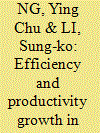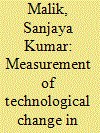|
|
|
Sort Order |
|
|
|
Items / Page
|
|
|
|
|
|
|
| Srl | Item |
| 1 |
ID:
089553


|
|
|
|
|
| Publication |
2009.
|
| Summary/Abstract |
The social science research performance of Chinese universities is examined using panel data. The universities are found to be very inefficient in general, with not much difference between regions. By far the largest single cause of universities? overall technical efficiency is pure technical efficiency, along with a considerable amount of scale inefficiency and a modest amount of congestion. No obvious regional differences in the universities? productivity growth are apparent between 1998 and 2002. Decomposition of the Malmquist productivity index indicates that although there has been technological progress over the years, poor scale efficiency and technical efficiency have resulted in deterioration in the universities? average productivity. There are signs of increasing congestion during the period studied.
|
|
|
|
|
|
|
|
|
|
|
|
|
|
|
|
| 2 |
ID:
137703


|
|
|
|
|
| Summary/Abstract |
This article measures technological change in India’s textile machinery industry, and examines how user–producer interaction affects this. Employing the non-parametric Malmquist productivity index, we find there has been little technological change in the textile machinery industry from 1998–99 through 2007–08. It is proposed that poor and unsustainable demand and the shrinking share of domestic demand for textile machinery owing to the technological upgradation fund scheme—meant for providing interest reimbursements or capital subsidies to textile manufacturers—may have weakened the user–producer interactions, thereby bringing down innovative activities and innovations in the textile machinery industry in India.
JEL Classification: O14, O33, C14
|
|
|
|
|
|
|
|
|
|
|
|
|
|
|
|
| 3 |
ID:
150343


|
|
|
|
|
| Summary/Abstract |
This study evaluates the energy efficiency trends of five energy-intensive industries in 23 European Union (EU) countries over the period 2000–2009. In particular, the performance of the construction, electricity, manufacturing, mining and quarrying, and transport sectors is examined. The analysis is based on Data Envelopment Analysis (DEA) combined with the Malmquist Productivity Index (MPI), which allows for distinctions between efficiency and technology changes over time. At the second stage of the analysis, cross-classified multilevel modelling is applied to analyse the main drivers behind efficiency performance using a number of sector and country characteristics. Based on DEA results, an overall improvement in efficiency is observed in all sectors over the period. The decomposition of the MPI indicates that technology change is primarily responsible for the improvements achieved in most sectors. The results obtained by the cross-classified model show, among other things, that the high electricity prices, energy taxes, and market share of the largest generator in the electricity market have a negative effect on industrial energy efficiency.
|
|
|
|
|
|
|
|
|
|
|
|
|
|
|
|
| 4 |
ID:
091555


|
|
|
|
|
| Publication |
2009.
|
| Summary/Abstract |
This article computes the energy productivity changes of regions in Japan using total-factor frameworks based on data envelopment analysis (DEA). Since the traditional DEA-Malmquist index cannot analyze changes in single-factor productivity changes under the total-factor framework, we apply a new index proposed by Hu and Chang [2009. Total-factor energy productivity growth of regions in China. Energy Policy, submitted for publication]: a total-factor energy productivity change index (TFEPI) that integrates the concept of the total-factor energy efficiency index into the Malmquist productivity index (MPI). Moreover, we separate TFEPI into change in relative energy efficiency, or the 'catching up effect,' and shift in the technology of energy use, or the 'innovation effect.' The data from 47 prefectures during the period of 1993-2003 are used to compute the TFEPI and its components for 4 kinds of energy. The TFEPI of electric power for commercial and industrial use changes ?0.6% annually, which can be separated into a total-factor energy efficiency change of 0.2% and a technical change of ?0.8%. The TFEPI for coal deteriorates by 1.0%/year, which is mostly caused by a decrease in relative energy efficiency change. We define and identify 'innovators' who cause the frontier to shift. Most regions identified as frontier shifters are located outside of Japan's four major industrial areas.
|
|
|
|
|
|
|
|
|
|
|
|
|
|
|
|
|
|
|
|
|